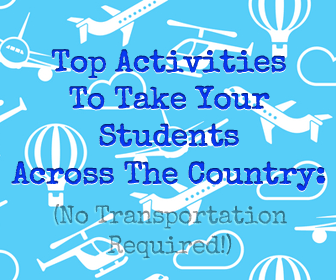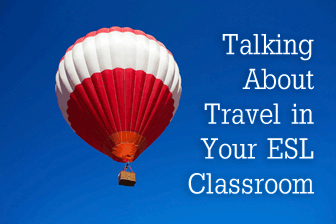Top Activities to Take Your Students Across the Country: No Transportation Required!


Have your students ever ridden a bicycle? Have they ridden in a hot air balloon? Have they ever taken a trip on the back of a mule or donkey? People all over the world use these means of travel on a regular basis, but sometimes one type of travel is obviously more appropriate than another. Thinking about unique types of travel like these, your students will have fun as well as get their creativity flowing as they come up with their own new means of travel! So strap on your seatbelts and get ready for an adventure that is sure to take you places, but who knows just where that might be.

Bicycle
Most people have probably ridden a bicycle at some point in their lives, but how far is too far for a ride? Dr. and Mrs. H. Darwin Mellrath spend three and a half years between 1895 and 1898 bicycling around the world (riding ships across the oceans, of course). With this in mind, challenge your students’ map reading skills (and non-pros reading abilities) by having groups plan a bicycle trip across the country or across the continent. Each group of four students should plan the best bicycle trip across the country using a map to plan the route keeping in mind the terrain and the weather. After each group has planned its trip, have students choose some resting points along the route from which to “send” post cards to the folks back home. You can display a large map on a classroom wall and post the post cards near the places from which they would have been “sent.” This exercise is a good opportunity to review with your class how to write and address a post card. The content, length and style are all different from that of a personal letter. You should then review with your students how to address a post card and what type of postage to use. Follow up the activity by having your students write real post cards to someone in their family or to a friend and then post and mail them.
Hot Air Balloon
If your class includes a literature element, you may want to consider reading the 1947 Newberry Winner for an excellent contribution to children’s literature, The Twenty-One Balloons by William Pene DuBois. Because of its target reading level, it may be more comfortable for your students to read than an adult oriented book at a higher reading level. In this book, DuBois writes about many inventions linked with the hot air balloon. Some are fictional, but many are historical. Your students will enjoy reading about a chariot pulled by hot air balloons, a hot air balloon RV and many other creative uses of hot air and fabric. After reading the book or portions of it, challenge your students to come up with their own hot air balloon invention. They may dream of a hot air parking garage or a balloon powered skate park. Whatever their imaginations come up with, ask the members of your class to write descriptions of their inventions. Each description should include the purpose of the invention, its uses or advantages, and who would most benefit from the invention. Then have your students illustrate their descriptions and post their work on a bulletin board titled “Up Up and Away.”
If desired, you can follow this activity up with a mock investors’ meeting. Give each person in the class a certificate for 1000 balloon dollars to invest in one of the inventions of a classmate. Each student should present his invention to the class stressing why it is the best option in which to invest. After all of the presentations, each person should commit his balloon dollars to one of the projects. If you like, divide your class into three teams and assign one of the top three inventions to each team. Have the group work together to plan how to make the project and what it would really cost to produce. You may also want to encourage each group to think of a marketing strategy to introduce the invention to the world.
Mule Rides
For visitors to Grand Canyon National Park, riding a mule down into the cavern can be a once in a lifetime experience. Ask your students if anyone has ever taken a mule ride. If so, ask that person to share about his or her experience. Then show your class some pictures of the Gran Canyon. In groups, have your students predict what it might be like to take a mule ride into the canyon. What might they need to bring? What might be prohibited? After some discussion time, have your students do some information gathering about mule trips into the canyon. You should encourage each group to look at the general information that the park provides about its mule trips, the FAQ, the do’s and dont’s and the rider qualifications. Give each group some time to revise their lists of what to bring and not bring. After reading and discussing the possible trips, have each person choose whether he would prefer a day trip or an overnight trip into the canyon on mule. Then each person should write a mock letter to the park administrator to reserve the trip he has chosen. Each person should include contact information, travel plans and a request for reservation.
Perhaps this imaginary travel will inspire your students to take an extreme trip in the months or years to come. Either way, their imaginations will get a spectacular ride as their English skills get a work out. Bon voyage and happy travels!